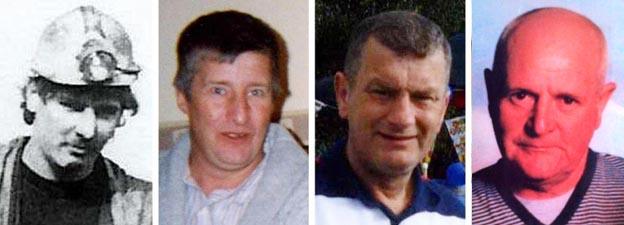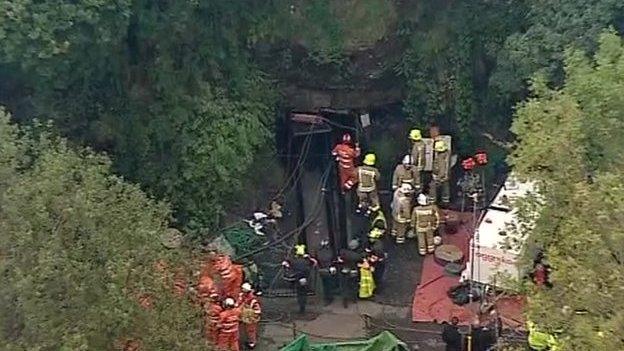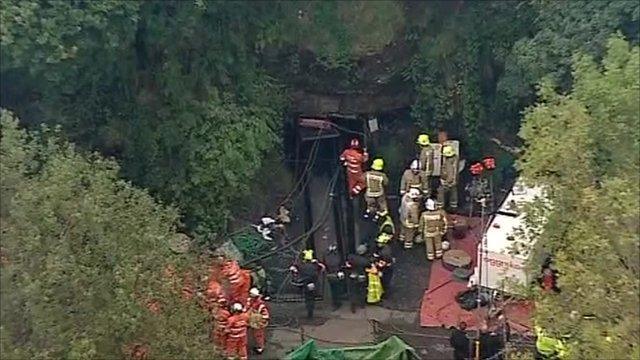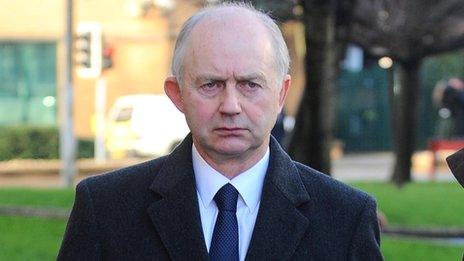Gleision mine deaths: Council official reported pit concerns, court told
- Published

Garry Jenkins, 39, Philip Hill, 44, David Powell, 50, and Charles Breslin, 62, were killed in the mine
A council official wanted a Swansea Valley mine closed before four men died there in 2011, a court has been told.
Neath Port Talbot Council planning officer Alan Rees told Swansea Crown Court he reported concerns about the Gleision mine twice, in 2009 and 2011.
David Powell, 50, Charles Breslin, 62, Philip Hill, 44, and Garry Jenkins, 39, died when the mine flooded following the use of explosives.
Malcolm Fyfield and mine owners MNS deny manslaughter charges.
Mr Rees told the court he knew that enforcement action had been considered before Mr Fyfield became manager of the mine, near Pontardawe, in July 2011.
He said there were "a number of things that weren't happening at this colliery with regards to the planning consent".

Malcolm Fyfield was one of seven men working in the mine near Pontardawe
On Friday, when giving evidence to prosecution barrister Gregg Taylor QC, Mr Rees told the jury that he had a meeting with Mr Fyfield the month before the four men died.
In that meeting he said he had seen Mr Fyfield drawing a black line on the map.
The prosecution said that line was what Mr Fyfield believed was the water level in the mine but he had miscalculated the amount of water.
The prosecution said it was a "simple and catastrophic mistake" which, when he ordered a coal face be blown through on 15 September 2011, allowed 650,000 gallons of water to flood in.
During her cross-examination Elwen Evans QC, defending Mr Fyfield, recapped the evidence Mr Rees gave on Friday.
She asked: "Is your evidence on oath that you actually saw him, in your presence, mark that black line?"
"Yes," Mr Rees replied.
"The note of your evidence about that black line is that was where he had inspected the water?" said Ms Evans.
"Yes," added Mr Rees.
"Where he had found the water?" she asked.
"Yes. He had been in and found the water at that level," Mr Rees said.
Sludge and dirt
But she then read a section of Mr Rees's police statement where he had told officers: "I didn't see Malcolm draw these markings but they were definitely on the plan."
Another section read: "Because he was able to show where he thought the water level was, I would imagine that Malcolm had been in there?"
Ms Evans said: "There's a world of difference between giving evidence that someone told you 'I have been in there' and what you did, repeatedly, to say to the police that you 'assumed' and 'I imagined'."
Mr Rees replied: "I stand by what I say. Mr Fyfield did tell me he had been in there to inspect the water."
Ms Evans then asked: "Are you definitely saying that Mr Fyfield told you that he had been in there to see that location?"
"Yes," he replied.
The court has heard that Mr Fyfield was one of seven men working in the mine at the time of the explosion and survived after he crawled out through sludge and dirt.
Mr Fyfield denies manslaughter through gross negligence, while the mine's operators MNS deny corporate manslaughter.
The trial continues.
- Published1 April 2014

- Published31 March 2014

- Published31 March 2014

- Published27 March 2014

- Published25 March 2014

- Published16 December 2013

- Published18 September 2013
